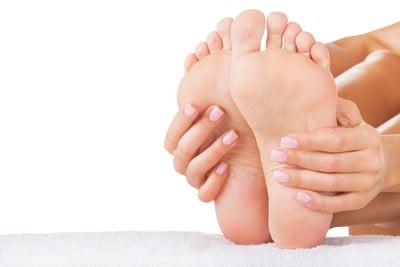Most leg pain symptoms are the result of wear and tear, overuse, or injuries of joints, bones, muscles, ligaments, tendons or other soft leg tissues. Symptoms of injury or overuse, and usually accompanied with leg pain, can include swelling, cramps, numbness, tingling, weakness, or changes in temperature and color. Leg problems may be minor or serious, and symptoms often develop from exercise, everyday wear and tear, or overuse. Children may have leg pain for similar reasons as adults or for reasons specific to children only, such as problems caused by over activity or the rapid growth of bone and muscle commonly known as "growing pains". Leg pain that is not related to a specific injury has many possible causes. Overuse may occur when one overdoes an activity, repeats the same activity, or suddenly increases exercise. Examples of overuse conditions include bursitis, tendinitis, shin splints, stress fractures, and plantar fasciitis. Muscle cramps in the leg can be caused by activity or dehydration, which can cause leg pain. Problems affecting the blood vessels (vascular disease) can include peripheral arterial disease, inflammation of a vein, or a blood clot, which may cause pain, swelling, or discoloration. Other diseases related to arthritis can cause joint pain, stiffness, and swelling.
Leg Pain Medical Treatment
Serious leg pain and other problems may occur and require prompt evaluation by a doctor. One who has pain during or after walking, swelling in both legs, worsening pain or painful varicose veins should schedule a doctor's appointment. Signs of infection, a swollen and pale leg or swelling in both legs along with breathing problems need more immediate leg pain treatment by a physician. A visit to the emergency room is necessary for a leg injury with a deep cut or exposed bone or tendon, if one is unable to walk or put weight on a leg, if there is pain, swelling and redness or warmth in a calf, or if there is an audible popping or grinding sound at the time of a leg injury. Medical treatment varies widely and depends upon the cause of leg pain and the individual's medical history. It can range from simple assistive devices like crutches to help keep weight off of an injury while it heals, to supportive braces, casts, or boots that keep an injured region straight to promote proper healing, to surgery, most commonly in the joints of the knee and hip.
Leg Pain Lifestyle and Home Treatment
Leg pain lifestyle and home treatments are often all that is needed to relieve symptoms and promote healing, and most minor leg problems will heal completely on their own. To help prevent cramps, one should stretch the leg muscles often, drink plenty of water and include lots of high-potassium food in one's diet. To relieve mild leg pain and swelling, one should stay off his or her legs as much as possible. Apply an ice pack or bag of frozen peas to the affected area for fifteen to twenty minutes three times a day. Elevate the leg when sitting or lying down. For best results, begin this treatment within forty-eight hours of an injury. Once the swelling subsides in two or three days, apply moist heat to help restore flexibility and range of motion. Compression, or wrapping, the sore area with an elastic bandage (i.e. an Ace wrap), will help decrease swelling. One should be careful to not wrap it too tightly, as this can restrict circulation too much and cause more swelling below the area. Gently massaging a painful or cramping area can relieve leg pain and encourage blood flow. Simply standing and moving the legs in a gentle motion may also help.



